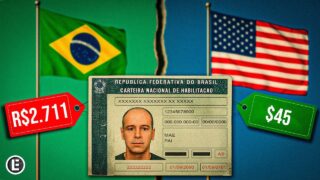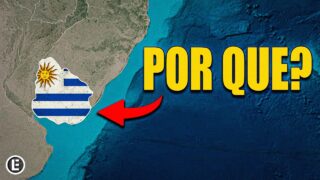The WILD Story of How the Mormons Created Utah
0(intense dramatic music) – It started with the murder
of their prophet in Illinois. Joseph Smith, leader of 26,000 Mormons, father to 14 children,
husband to 40 wives. The prophet, seer, and revelator was dead, and the Mormons were under attack. So they fled. They found safety in
the mountains of Mexico where they would go on to build
their own utopian society, building the promised land
with its own language, symbols, government, and economy, and a new prophet speaking for God, leading the church’s growth, taking 56 wives of his own, and continuing Joseph’s vision of building Zion in the mountains. Here in the Wild West, the Mormons would go on to draw this shape as the borders for a state of their own, something that would lead them into a war with the United States government, nearly destroying
everything they had built. It’s a conflict that
helped build the West, and it certainly shaped these people, eventually shaping me,
the stories that I heard, the culture that I grew up in, the university I attended, the way I saw the world. This is a complicated and sensitive topic, and as always, my
sources are in a document in the description. Please scrutinize and critique
them if you don’t agree. I look forward to an interesting
discussion in the comments. With that, let’s dive into part two of the “Rise Of The Mormon Church.” (apprehensive music) Watching part one of this
series will be helpful if you’re unfamiliar with Joseph Smith or the establishment of the Church of Jesus
Christ of Latter-Day Saints or the Mormon Church. So this is part two, and
we’re starting in the 1840s when the Mormons are kicked
out of Illinois and Missouri, and they make this 1,000
mile grueling journey into what was then the
remote mountains of Mexico. – [Narrator] Your forefathers and mine came to this country in the first place for one great reason, to escape persecution for their beliefs, and to build a free country where everybody might
worship God as he pleased. – Yes, all of this was
Mexico for a very long time. The Mormons believed,
and still do believe, that someday they would return to the sacred land of
Jackson County, Missouri, where they would help usher
in the end of the world and the Second Coming of Jesus Christ. But for now, they would build Zion in the mountains of Mexico far away from the American
government and people, or at least so they thought. And this is where things get
really interesting to me, because right after the Mormons
arrive to these mountains, they start building, and
they start building fast. They used the same designs
that Joseph Smith had drawn up for the city of Zion, placing the holy temple at the center. Around this temple, they would build their
city as a perfect grid. But what’s most impressive to me is how well they cooperated and coordinated with each other, how motivated they were, how industrious and productive they were. They worked tirelessly
for their vision of Zion, and this became a core part
of the Mormon identity. They ended up adopting the beehive as a metaphor for their community, a group of industrious,
highly motivated people, all working together for a common goal. According to the Mormon
scriptures, the Book of Mormon, there’s an ancient word for honeybee, that word is “Deseret.” And Deseret would soon be the
name of their proposed state. And it became a foundational symbol for these people building their Zion in the mountains of Mexico.
(upbeat music) Okay, but they didn’t just build
one city next to Salt Lake. Very soon after arriving, Brigham Young sent members
of the church north and south to repeat the same pattern, to find an area to build it up quickly with this same grid design, putting the temple in the middle, and begin developing
and settling this land. (upbeat music) In a very short time, the Mormons spread throughout
this mountain west area, building a network of settlements, and displacing native
people in a lot of cases, sometimes peacefully with treaties, but other times with violence. I can’t emphasize enough how
industrious these people were. They were doing things that no one else was doing out in the West. They were building
sophisticated ditches and canals and reservoirs, getting
water into this arid land so that they could farm and grow. They were mining metals,
they were very productive, and then they would share
their surplus with one another, because in their mind, Zion was a place of
one heart and one mind, there would be no poor among them, the community was more
important than the individual. Which was the complete opposite of what most settlers
were thinking and doing in the American West at the time. Shortly after the Mormons arrive, 1848, thanks to a victory against Mexico, the U.S. gets all of this land, which places the Mormons
back inside the borders of the United States. But still, the government didn’t have a lot of control out here, this was still the Wild West. Most people coming out
here were White settlers in search of a new life, pursuing their dreams of freedom, of abundant land, of riches and gold out in the Wild West. And right in the middle of all of this, this group of industrious Mormons, driven by obedience and sacrifice and a commitment to communal living, preparing for the end of the
world, for the millennium. This is a tension that will
blow up in just a second, but first we need to talk about how popular the Mormon Zion was becoming. (jaunty music) Brigham Young had sent
missionaries all over, but especially to Europe, to the west coast of England specifically, where these missionaries
would preach the word of the restoration of the Gospel and the building of Zion
in the American West, and it really was effective. When I was a Mormon missionary in Mexico, we would hear stories about
these Mormon missionaries out in England who were doing
this initial missionary work. And honestly, these guys
were like legends to us, they were so successful. The Mormons back in Salt Lake would pool their money together and help pay for the way
of these new converts across the ocean, across the continent, to come join them in building Zion. My great-great-great
grandmother and grandfather were some of these converts from Wales. They were converted by
a missionary in Wales and then made the grueling
trek with their children, eventually ending up
north of Salt Lake City where they contributed to building Zion. So for me, and a lot of people who grew up with “Pioneer Heritage,” as
we call it in the church, these stories of sacrifice
become a foundational part of our belief in our faith. Why else would our ancestors
have sacrificed so much to build this church?
(upbeat music) Brigham Young’s society of worker bees started to become more than just a religious
community in the mountains. They were starting to look a lot more like a theocratic society, with the prophet as the
head of their government. They had schools, they had newspapers, their network of settlements
created a complex economy that was run by the church
who directed everything, where to build, what to build. Soon they had their own currency. They made these really unique coins, some featuring their
unique symbols, handshakes, and a reminder that union is strength. Or here we see the beehive again, and a reminder to do your duty. They’re building sugar mills and processing iron
and building factories, and they even invented
their own writing system like their own alphabet, which was meant to unify the people around a common way to
spell and pronounce words. I actually have a reprint here
of the “Deseret Alphabet.” They never taught us how to read this, which I’m kind of bummed about because I would love to
know what this all says. (dramatic music) But there was a big
problem for the Mormons, which is that this was
all now the United States and the federal government was exerting more and more control West as more and more people settled out there. Once again, this could be the end of the Mormon’s vision of Zion. So they acted very quickly and decided to propose
a state of their own, telling the government that, “Hey, we know you didn’t like us settling in Missouri or Illinois, but we’re out here in the West and we’ve settled and
developed all of this land in a really short time. Please let us have our own state so that we can practice
our religion as we please.” And what is the state that they proposed, this massive shape.
(upbeat music) Take a moment to soak this in, look at where we are here. These borders for the
proposed Mormon state encompass parts of modern day Arizona, Southern California, Colorado, Idaho, New Mexico, Oregon, Wyoming, and Utah. This thing is huge, if
it had become a state, the modern United States would
look something like this, bigger than Washington, Oregon,
and California combined, and they would call it
the State of Deseret. They were serious. They drafted a constitution and they lobbied hard for their state. And the U.S. government said “Absolutely not, of course not.” The government didn’t
love that the Mormons were building this theocratic society that was completely independent
from the United States. But they did kind of like how
industrious the Mormons were, how effective they were
at settling this land, displacing the natives, and building up communities
for White people. This is something the United
States was doing at the time. It was their manifest destiny, and the Mormons were really good at it. So, in order to keep the Mormons productively settling the land that they had just won from Mexico, the federal government does
grant them this territory, not as big as the State of Deseret, but still a nice big territory. And they let Brigham Young, the prophet of the church,
be the first governor. Now, the US Congress did
not want to name this after a word from the Book of
Mormon that means “beehive.” So they named it Utah, after the local Ute Natives, who this land had been taken from. Little fun side note here, the Washington Monument
here in Washington D.C. was built using stones from
every state and territory. And as this negotiation was going down, the stone that made it into
the Washington Monument says, “Deseret,” not “Utah.” It’s got the beehive and a big eye that says
“Holiness To The Lord,” the most Mormon symbol you could ever have right here in the Washington Monument. (jaunty music) So the Mormons now have a territory called Utah Territory,
it’s not a state yet. President Brigham Young is their governor and their prophet, and they can continue
to build Zion in peace. But the government now
sort of has an eye on them. They send in some federal employees to like keep an eye on the Mormons, make sure they don’t get too revolutionary with their theocratic government and their apocalyptic ideas. They’re once again back
on the government’s radar. The government’s like
“They better start behaving like Americans. They need to quit it with the whole, ‘We’re making our own
government and society for the coming of Jesus thing,’ or things are gonna get messy.” (jaunty music) And now, we have to talk about polygamy. Some of you have been
waiting the whole time to hear me talk about polygamy. Well, here it goes.
(playful music) You’ll remember from part one that when Joseph Smith was
the leader of the church, he came out and said that
the Lord had commanded him to take multiple wives, that this was a part of the
new and everlasting covenant, which is the law of marriage for Mormons. Joseph ended up marrying around
40 women in his lifetime, some of them very young. But polygamy wasn’t for everyone at first. Joseph invited a few select church leaders and people in his circle
to participate in polygamy. And they continued doing that. Brigham Young also did this, but in kind of a hush hush way for a bit. That isn’t until 1852, a couple years after Utah
Territory was created. Prophet Brigham Young stands at the pulpit of this very beautiful building and tells the members of the church that plural marriage or polygamy
is a divine law from God, a superior way of life, practiced by the prophets of old. And in this conference, he cites Joseph Smith’s
revelation on marriage, saying that marriage, including
plural marriage or polygamy, is the only way to be exalted, which is the Mormon way
of saying to become a God, which is the ultimate
goal In Mormon doctrine. The thinking was that plural marriage would allow more worthy
women to marry a worthy man and have the opportunity to be exalted. Brigham Young went on to marry 56 wives. He had kids with 16 of
them, 57 children in total. Some of these wives were older widows that Brigham said he married
just to take care of them, and some of them were 13 years old. So now that the prophet
had openly endorsed it, it was public, this was out. More and more Mormon men
began practicing polygamy, taking mostly younger
women as their extra wives. If you wanna look at this graph, pause the video or go look in my sources ‘cause it’s pretty
interesting, but let’s move on. So unsurprisingly, the
government does not like this. Some lawmakers in
Washington D.C. see polygamy as the equivalent of slavery, something that, at the time, was a fierce debate in the country, something that was about
to turn into a civil war. And as the government exerts more and more control
out here in the West, they become less and less comfortable with the Mormons building
their own theocratic, utopia, communal society within the borders of the United States. And Brigham Young, the
governor and prophet, is not helping the situation, writing to his followers
that the world is, quote, “on the eve of revolution,” giving speeches to his
lawmakers in Utah Territory saying that, quote, “The
government is going to pieces and that when the time comes, we shall be called the kingdom of God,” like the church is the real government. So is this freedom of religion or a brewing revolution by an apocalyptic religious group? Add to this that more and more Americans are hearing about polygamy
and are disgusted. You can see this in this
waterfall of political cartoons. (jaunty music) Brigham Young at home
with all of his wives, all the wives fighting in
bed while the babies cry, an “Elders’ happy Home.” I mean, this stuff is kind of
snarky and fun or whatever, but you also see some more violent and dehumanizing depictions like Uncle Sam marching
with his sword into Utah, the “Mormon Vermin Nest,” or lines of women marching
into a skull labeled “Utah.” The media starts portraying
Mormons as a different race, less White than other Americans. (jaunty music) But the Mormons don’t budge on polygamy. It’s a law of God, it’s
very black and white, their prophet has said so. And in fact, they kind of double down. Mormon leaders start defending polygamy saying that it’s a healthier way of life. “Monogamy makes a man dry up and wither, but a man with lots of wives looks fresh and young and sprightly,” why? “Because God loves that man.” Or here’s another one, “Polygamy promotes
life, purity, innocence, vitality, and health.” “Monogamy engenders
disease, disappointment, and premature death.” Wow, these are in bold claims. Eventually, the federal
government has had enough. They see this as an open rebellion happening within their borders, and that’s when they call in the troops. (upbeat music) War is coming to Utah and Brigham Young prepares his men, calls them back from their missions, rallies his militia to fight back against
the federal government that wants to end their Zion. Now, the Mormon militia
called the “Nauvoo Legion” is not gonna win against
the United States Army. So they resort to kind
of insurgent tactics. They start kind of terrorizing the supply lines, burning stuff. They create these cattle stampedes, they block canyons, anything to slow the federal troops down. At one point in the middle of all of this, a group of the Mormon militia happened upon a group of settlers who are traveling to California. They have a standoff, and eventually the Mormons
end up tricking them into coming out and
giving them their guns, at which point they go on to massacre almost the entire group, 120 men, women, and children. Only a handful of children were spared, and they were the ones who were too young to remember what was happening. But despite this increased tension, this event known as the
“Utah War” never escalates into a full-blown battle between the army and the Mormon militia. Brigham Young ends up backing down. The Mormons negotiated with the government saying that they would allow the army to come into Utah to
keep an eye on things. Brigham Young also had to step down and the government would be
replaced with more non-Mormons. So there was a ton of troops in Utah, this time, it’s the 1860s, and the Civil War breaks
out over in the East. And at that moment, the largest group of federal
troops are stationed in Utah, keeping an eye on the Mormons. But even still under all of this scrutiny, people keep coming, the Mormon communities keep growing, Mormon men continue to
take multiple wives, the government feels like
they’re being ignored. So back in Washington D.C., lawmakers decide it’s time to end the Mormon project once and for all. And this time, they’re
gonna do it with laws. (upbeat music) They pass a series of
laws that make polygamy or anything like it illegal. The Mormons are now
officially breaking the law, and thousands are rounded
up and put in jail. And crucially, this law also
gives the government power to seize the church’s
property, like their funds, their buildings, including
their precious temples, the most important place in Mormonism. The government could argue, and the Supreme Court would agree that these temples where
Mormons get married were being used to break the law because they were being used to marry men to multiple women, which was now a felony under the law. Temples were the final
straw for this community. It represented what could
be the end of their church. So the prophet at the
time, Wilford Woodruff, comes out and says that the
Lord has showed him a vision of what will happen if they don’t give up practicing polygamy. He said that their holy
temples would be taken away. Their men, including their top leaders, would all be thrown into jail, and it would be the end of the church. I mean, he wasn’t seeing the future here, this was already happening, and this was logically the
next step for the church. So he commands the members to stop. Many members of the church listened and many totally ignored it and continued to practice
plural marriage for decades. This includes seven of the top
leaders called the Apostles who continued to practice polygamy even after the manifesto. The church did come out a
few years later and said, “No, really, you have to stop or we will excommunicate you.” And even still, some disagreed, leading to a group of them to gather in a small desert community in Arizona where they continued to practice polygamy, which they were told was a celestial law. They eventually became
the Fundamentalist Church of Jesus Christ of
Latter-Day Saints, or FLDS, where today they remain, where 30,000 members live in
these insular communities, continuing the practice of polygamy. That is a whole other
rabbit hole for another day. Mainstream Mormons did
eventually get totally on board and do not practice polygamy
in any kind of significant way. And Utah was eventually made a state. Today, the descendants of
those original pioneers live in Mormon communities
along this corridor that Brigham Young settled. My wife and I went to school
right here in the heart of it, in this beautiful valley, surrounded by these massive mountains, feeling close to the
specific sugarcoated version of this history that I was taught. These stories of struggle and conflict, sacrifice in the name of your beliefs, bravery in the face of persecution, a work ethic, and a discipline, and an obedience that I was shaped by, huge part of my identity and the identity of a lot of LDS people. But what I’ve learned
is that that identity is deeply linked to exploitation
and apocalyptic thinking, exploitation of Mormon women and children, the theft of native land, obedience to a God whose will is strangely aligned with
the incentives of men, a belief that the world will end any day, which justifies all of this. A confirmation that we
were the chosen people, the real Israel, called of
God to prepare the world for the end, to gather the tribes before the Savior’s return. I still don’t fully understand how I could find such meaning and beauty in something that I now
find to be so wrong, to be so damaging. And yet there’s a third and
final part to this story that you have to understand if you want to understand
the Mormon experience. I’ll eventually be making a third video where I explain a bizarre
pivot that happens where the Mormons go
from being a rebellious, apocalyptic group in the mountains, fighting with the federal
government, to embracing it, growing the church into
a global organization who has used that same
beehive, cooperative work ethic to become wealthy and powerful, wielding over 100 billion
dollars in financial assets, all with the goal of building Zion in preparation for the end of the world. It’s the same goal that
motivated Joseph Smith to start the church, the same goal that kept the Saints going with Brigham Young and
building out the mountain West. And it is the same goal that motivates members
of the church today.









